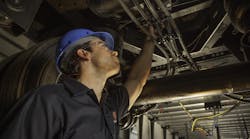Safety should be every driver and fleet operator’s number one priority, stresses Tony Neven, aftermarket service manager at Great Dane. Do the required pre-trip inspections, and safety and maintenance checks, to ensure that deliveries will be made safely and efficiently.
Great Dane (www.greatdanetrailers.com) is a manufacturer of high-performance commercial transportation equipment, including dry and refrigerated trailers and truck bodies, as well as steel, aluminum and combination platform trailers.
“Preventative maintenance (PM), as the name implies, is designed to catch small issues at an early stage to prevent them from becoming major breakdown expenses on the road, and to ensure the trailer is safe for highway travel,” Neven explains. “The time spent on PM will reward you in the long run by keeping vehicles moving, not dealing with an unanticipated repair.”
Probably the most important decisions that have to be made for an effective PM program, suggests Neven, are how often to perform preventive maintenance and how to ensure it happens on time.
“This naturally will vary depending on trailer age and the load conditions,” he says.
INSPECTION POINTS
Most PM program checklists cover a wide variety of visual and mechanical inspections at intervals from 90 to 180 days, Neven observes. Normal items to inspect more frequently include:
- Tires.
- Wheel ends/lubrication.
- Undercarriage.
- Landing gear.
- Upper coupler and kingpin.
- Torque values and weldments on suspension items.
- Brake shoes and drums.
- Air lines.
- Electrical system, lights and wiring.
Great Dane’s maintenance manual (PDF) – available online at bit.ly/gdmanual – was created to help ensure the safety, dependability and performance of its trailers.
“It is essential that trailers receive periodic inspections, maintenance and service parts replacement,” the company’s Neven emphasizes.
A STARTING POINT
PM starts the day you take possession of the trailer, Neven says. The most critical time in a new trailer’s life is its initial in-service check and first month’s “shakedown.”
“PM technicians should be alert for underinflated tires and threaded fasteners that may have loosened from factory-torque settings,” he says. “Fastener torque checks should be all-inclusive. Look at refrigeration units, tanks, steps and carriers – anything that is fastened to the trailer. You don’t want something coming loose on the road.”
Areas that deserve particularly close attention during the first 30 days include:
- Tires.
- Wheels.
- Leaf spring suspensions.
- Air spring suspensions.
- Sliding tandem operation.
- Air system and brakes.
- Brake maintenance.
- Doors.
Pay special attention to tires, emphasizes Neven. Running a tire underinflated can have serious consequences, in addition to reducing tread life. Heat buildup can cause the tire body to deteriorate, resulting in separation of the tread from the body or belt ply.
“Well maintained tires will keep you on the road,” Neven says.
BODY FOCUS
Neven points out that the trailer itself needs attention. The body of the trailer, including the sides, roof, floor and interior, should be checked for damage frequently to prevent water intrusion or, on refrigerated trailers, thermal loss.
Winter corrosion maintenance is important in areas where magnesium and calcium chlorides used to control snow and ice on highways can cause corrosion, he adds. If not cleaned from equipment after each trip, the chemicals will cause rust and corrosion damage in as little as one winter.
Don’t neglect the trailer’s appearance, he adds. A well-maintained trailer with a company’s logo on it sends a positive message about that company mile after mile. Moreover, how well trailers are maintained has an effect on trade-in value and a company’s brand reputation.
VENDORS
When using outside service vendors for trailer maintenance and service, Neven says the best practice to ensure that a fleet’s regimented PM policies are followed to exact specifications is to use a single network of quality, factory-trained and managed service providers.
“There should be no allowance for individual interpretations of what is expected when performing the preventive maintenance,” he says. “Work with a single network of service providers who have a clear understand of your fleet’s preventive maintenance specs and follow up with an on-going audit of the maintenance.
He notes that Great Dane provides such a consistency and quality solution with its AdvantEDGE North American national parts and service program.
Finally, Neven says “everyone should follow their operation’s maintenance procedures and the trailer’s owner’s manual recommendations to ensure warranty protection.”




